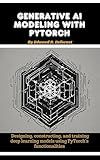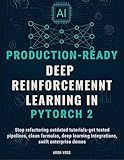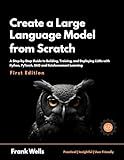Best Early Stopping Techniques to Buy in December 2025

PyTorch Pocket Reference: Building and Deploying Deep Learning Models



Machine Learning with PyTorch and Scikit-Learn: Develop machine learning and deep learning models with Python



Generative Ai Modeling With Pytorch: Designing, constructing, and training deep learning models using PyTorch's functionalities (Ai programming from beginner to expert)



Production-Ready deep reinforcement learning in PyTorch 2: Stop refactoring outdated tutorials—get tested pipelines, clean formulas, deep learning integrations, swift enterprise demos



Create a Large Language Model from Scratch: A Step-by-step Guide to Building, Training, and Deploying LLMs with Python, PyTorch, RAG and Reinforcement Learning


When training models with PyTorch, early stopping is a technique used to prevent overfitting and improve generalization. It involves monitoring the model's performance during training and stopping the training process before it fully converges, based on certain predefined criteria.
To implement early stopping in PyTorch training, you can follow these steps:
- Split your dataset into training and validation sets. The validation set should be representative of the data distribution but not used for training. This set will be used to monitor the model's performance.
- Create a validation function that evaluates the model's performance on the validation set. This can be done by calculating a suitable evaluation metric like accuracy, loss, or any other relevant metric.
- Define parameters for early stopping, such as the maximum number of epochs to train, minimum improvement required to continue training, and patience (the number of epochs to wait for improvement).
- During the training loop, after each epoch, run the validation function to assess the model's performance on the validation set.
- Track the evaluation metric obtained from the validation function. If the metric doesn't improve by a predefined amount for a specified number of epochs (patience), early stopping can be triggered.
- Implement a mechanism to save the model's weights or state when the best evaluation metric is achieved during training. This allows you to retrieve and use the best model obtained.
- Keep track of the current best evaluation metric, and compare it with the obtained metric from each validation step. If the obtained metric is better, update the best metric and save the current model.
- Continue training until the early stopping criterion is met. This can be when the maximum number of epochs is reached, or when the model's performance fails to improve for the specified number of epochs (patience).
- Finally, use the saved weights or state of the best model for further evaluation, inference, or any other tasks.
By implementing early stopping, you can prevent model overfitting, save training time, and obtain the best performing model based on the chosen evaluation metric.
How to implement early stopping in PyTorch training?
To implement early stopping in PyTorch training, you can follow these steps:
- Define a loss function and an optimizer for your model. This will typically involve creating an instance of a loss function class (e.g., torch.nn.CrossEntropyLoss()) and an optimizer class (e.g., torch.optim.SGD()).
- Create a loop for your training epochs. Inside this loop, you will perform forward and backward passes, compute the loss, and update the model's parameters using the optimizer.
- Define variables to keep track of the best model and the corresponding performance metric (e.g., validation loss or accuracy). You can initialize the best metric value as infinity (float("inf")) or negative infinity (float("-inf")) based on your evaluation metric.
- Within the training loop, after each epoch, evaluate your model's performance on the validation set. Calculate the desired evaluation metric (e.g., loss or accuracy) for the validation set using the current model's parameters.
- Compare the validation metric value with the best metric value obtained so far. If the current metric value is better, update the best metric value and save the model parameters.
- Implement a stopping criterion by defining a patience value. This value determines for how many subsequent epochs you are willing to tolerate no improvement in the metric. If the metric does not improve for this number of epochs, you can stop the training loop and return the best model.
Here is a sample code snippet to illustrate the implementation:
# Define your model, loss function, and optimizer model = MyModel() loss_fn = torch.nn.CrossEntropyLoss() optimizer = torch.optim.SGD(model.parameters(), lr=0.01)
Define variables for early stopping
best_metric = float("inf") patience = 5 counter = 0
Training loop
for epoch in range(num_epochs): # Training model.train() # Perform forward pass, backward pass, and optimization # ...
# Validation
model.eval()
# Evaluate your model on the validation set
# ...
# Compare with the best metric obtained so far
if val\_metric < best\_metric:
best\_metric = val\_metric
counter = 0
# Save the model parameters
torch.save(model.state\_dict(), 'best\_model.pt')
else:
counter += 1
# Check if the stopping criterion is met
if counter >= patience:
print("Training stopped. No improvement in validation metric.")
break
In this example, the training loop will stop if the validation metric does not improve for patience number of epochs. The model's parameters at the point of the best metric value will be saved as best_model.pt. Remember to adapt this code to your specific scenario, including defining your model, performing forward and backward passes, and evaluating on the validation set.
How to choose the appropriate threshold for early stopping?
Choosing the appropriate threshold for early stopping can be a subjective decision and may depend on the specific problem you are working on. However, there are a few general guidelines to consider:
- Monitoring metric: Select a metric that reflects the performance of your model and use it to monitor the training progress. This metric could be something like accuracy, loss, F1 score, or any other relevant evaluation metric.
- Evaluation on validation data: Split your data into a training set and a validation set. During the training process, evaluate the model's performance on the validation set at regular intervals (e.g., after each epoch). This will help you track the trend and stability of the metric.
- Determine the threshold: Look at the progression of the monitored metric over time. You might notice that initially, the metric improves significantly but starts to plateau or even degrade after a certain number of training iterations. The threshold should generally be set just before this degradation or plateauing point.
- Early stopping criteria: Once you have identified the threshold, you can define your early stopping criteria. For example, you can stop the training process if the monitored metric has not improved by a certain pre-defined margin (e.g., no improvement in the last 5 epochs), or if it starts to degrade beyond a certain margin (e.g., consecutive epochs with increasing loss).
- Experimentation: You might need to experiment with different thresholds to find the one that works best for your specific problem and dataset. It's also worth considering other factors like computational resources, time constraints, and the trade-off between training time and model performance.
Remember, early stopping is a balance between stopping too early (underfitting) and stopping too late (overfitting). It is essential to find the right trade-off to prevent overfitting while achieving good model performance.
How to choose the best metric for early stopping?
When choosing the best metric for early stopping, you should consider the following factors:
- Task-specific metric: Choose a metric that is directly related to the task you are trying to solve. For example, if you are working on a classification task, accuracy or F1 score might be suitable metrics. If you are working on a regression task, mean squared error or mean absolute error could be appropriate.
- Evaluation on validation set: Use a separate validation set to evaluate the performance of your model during training. This set should be representative of the data you will encounter during real-world scenarios. Choose a metric that aligns with your goals for the task, such as maximizing accuracy or minimizing loss.
- Sensitivity to model performance: Select a metric that is responsive to changes in model performance. For example, accuracy is a commonly used metric, but it may not be suitable when dealing with imbalanced datasets. In such cases, you might consider precision, recall, or F1 score, which provide a balanced view of model performance.
- Interpretability: Choose a metric that is easy to understand and interpret. This is especially important if you need to explain the model's performance to stakeholders or non-technical individuals. Metrics like accuracy or area under the ROC curve are generally easier to explain than more complex evaluation metrics.
- Consistency with other metrics: Consider other metrics that might be relevant to your task. For example, if your model needs to consider both accuracy and computational efficiency, you may want to choose a metric that balances both requirements.
- Business requirements: Take into account any specific business requirements or constraints. For example, if your model is deployed in a resource-constrained environment, you might prioritize metrics that minimize memory usage or inference time.
It is important to note that the choice of the best metric for early stopping may vary depending on the specific task and dataset. Therefore, it is recommended to experiment with different metrics and choose the one that best aligns with your goals and requirements.
